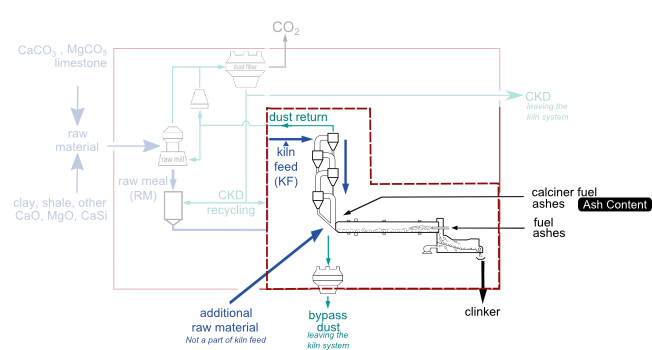Input Method Dust Return Correction
Figure 5: Diagram of a kiln mass balance

Which values and parameters are required regarding dust?
If you take a look at the Sheet CalcA1 (Simple Input Method) or Sheet CalcA2 (Detailed Input Method) you will find the following lines for reporting the values of the dust mass flows:
- Dust return correction of kiln feed: line601 and line501
The correction of the kiln feed by the rate of dust return prevents double counting of recycled dust. - CKD leaving the kiln system (dry weight): line655 and line510
- CKD CO2 released from total carbon (TC)1 on line656 or CKD loss on ignition LOICKD on line511
- Bypass dust leaving the kiln system: line650 and its residual CO2 from TC in line651
Which methods can be used to calculate the dust return correction?
The fraction of dust return with reference to the kiln feed shall be determined at plant level. For that purpose different methods can be applied. The necessary evaluations shall be documented in addition to the Protocol Spreadsheet. Two common methods for determining the dust return correction are the following:
1) Dust return weighing:
If you have the equipment in your plant which allows you to weigh the dust return directly, then you can use data recorded by your weighing system for the dust return and relate it to the data recorded for the amount of kiln feed in certain periods or through the year in order to determine the dust return correction.
2) Determining the fraction of dust return from a kiln mass balance:
The fraction of the dust return can also be determined from a kiln mass balance. For this method the weighing of clinker and the analysis of the input materials and fuel ash content is required. For the calculations you can use the following mass balance formula:
summation of mass entered to kiln = summation of mass leaving the kiln
Then:

where:
- KF = Kiln feed in tonne per day (t/d)
- DR = Dust return correction in percentage (%)
- P = Clinker production in tonne per day (t/d)
- F = Fuel consumption in tonne per day (t/d)
- FA = Fuel ash content in percentage (%)
- ARM = Additional raw materials in tonne per day (t/d)
- LOIARM = Loss on ignition of additional raw materials in percentage (%)
- BypassD = Bypass dust in tonne per day (t/d)
- LOIBD = Loss on ignition of bypass dust in percentage (%)
- LOIRM = Loss on ignition of raw meal dust in percentage (%)
In any case, the methods applied for determining the fraction of dust return and the kiln mass balance should provide sufficient accuracy. If the determination is based on certain periods of kiln operation, these periods have to be representative for the operation of the kiln during the reporting year.
Please see Example for calculating the dust return correction for an example on how to calculate the dust return correction.